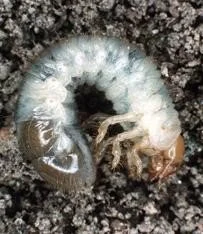Dung Beetles and their Benefits to Farmers
Dung beetles have been revered for their strength and importance to agriculture for thousands of years. They exist in all continents, except Antarctica. Those species native, or introduced to Australia play a significant role in nutrient cycling by burying and consuming animal dung. Their presence provides invaluable benefits to farmers, livestock and the wider environment. In the Burnett and Mary River catchment systems, there are several species of dung beetles that have adapted to the region’s conditions.
Life Cycle
A dung beetle can live for one to two years, during which time it will fertilise and enrich the soil around it, sequestering carbon and improving soils for pastures and microorganisms. After mating, the female lays her eggs within a brood ball, made by the male, from freshly deposited animal dung. When the larvae hatch, they feed on the dung and undergo three stages of growth, shedding their skin each time, before pupating and metamorphosing to emerge as an adult beetle.
Activity
Dung beetles are most active during the warmer months of the year, with peak activity varying between species. During this time, they tirelessly work to remove dung from pastures, burying it beneath the soil where it becomes a rich source of nutrients for plant growth. This process not only improves soil quality but also suppresses the breeding of pest and disease-carrying flies, ultimately reducing the need for costly insecticides. While the adults can eat mushrooms, leaves, and rotting vegetation, the adult dung beetles have mouth parts which are specially adapted to feed on liquefied material and can break down a dung pad very efficiently by burying the dung underground to use when breeding.
Australia has more than 500 species of native dung beetles and over time, 29 species of dung beetles have been successfully introduced by the CSIRO from Hawaii, Africa, and southern Europe. Australia’s native dung beetles which evolved in tandem with marsupials, are not well suited to use and disperse the comparatively wetter cattle dung effectively. The introduced dung beetles are very useful in Australia’s agricultural regions, but are not uniformly dispersed, nor do they have extensive ranges. Physical barriers such as mountains, and water bodies can hinder their movements.
According to the Australian Museum, dung beetles have three body parts – a head, a prothorax and an abdomen. The typical beetle’s body consists of a hard outside cuticle and folded wings that lie over the upper surface of the abdomen and are covered by wing covers.
The wings are transparent or whitish in colour and are only visible if the beetle is in flight.
Dung beetles have six legs that are specialised for shovelling dung and earth.
Dung beetles come in a variety of colours. Some are rollers, some are tunnellers, and others are dwellers. The most common colour of dung beetles in Australia is black. In the Burnett and Mary River catchment systems, several introduced dung beetle species are common, including Euoniticellus intermedius, Liatongus militais, Onitis alexis, Onitis viridulus, Onthophagus gazella, Sisyphus rubrus, and Sisyphus spinipes, which are active in summer, autumn, and spring. Onthophagus nigriventris is the only species active throughout the cooler months of autumn and winter
(From Which species are near you? | Dung Beetle Ecosystem Engineers (dungbeetles.com.au))
These species have adapted to the region’s soil types and vegetation and have increased over time thanks to targeted breeding programs by farmers and government agencies.
Benefits to Farmers and Livestock
Dung beetles provide several benefits to farmers and livestock, including better nutrient cycling, improved pasture growth rates, reduced parasite pressure, better aeration, reduced compaction, reduced runoff after rain events, and decreased ammonia levels. By removing dung from pastures, farmers can significantly reduce the fly and nematode populations, providing a more comfortable environment for both livestock and workers. Additionally, dung beetles can reduce the spread of diseases such as E. coli and salmonella by burying dung before flies can contaminate it. They also increase the available land for pasture, by removing the cow pats that might otherwise accumulate and persist for long periods.
Threats
Despite the many benefits of dung beetles, they face several threats from farming practices such as drenching chemicals and non-targeted insecticide use. Drenching chemicals administered to livestock can remain active in animal dung for several weeks, killing off beneficial beetle populations. In addition, non-targeted insecticides used to control pests can kill off both pest and beneficial insects such as dung beetles, resulting in severe ecological imbalances. The introduction of cane toads to the region has also been a significant threat to the survival of dung beetles, with the toads finding their way to fresh cow pats at dusk and lying in wait for the beetles to home in on the scent. This reduces the population of adult beetles and disrupts their breeding cycles.
Conclusion
Dung beetles play a crucial role in nutrient cycling and ecological balance in the Burnett and Mary River catchment systems. With targeted breeding programs, careful use of insecticides and drenching regimes, farmers can increase the population of dung beetles, providing invaluable benefits to themselves, their livestock, and the wider ecosystem. With careful land management practices, we can ensure the continued existence of these vital insects for years to come.



